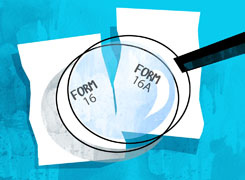Ramalingam Kalirajan |10878 Answers |Ask -Follow
Mutual Funds, Financial Planning Expert - Answered on May 27, 2024
He has an MBA in finance from the University of Madras and is a certified financial planner.
He is the director and chief financial planner at Holistic Investment, a Chennai-based firm that offers financial planning and wealth management advice.... more

Sir, my daughter is now Canadian citizen, she has been investing in MF thru her NRE account. Her accumulated corpus is now appx 3Cr. She want to encash her portfolio and wish to take back that amount to Canada What will be her tax liability in India and in Canada. SKGupta Dehradun
When your daughter, a Canadian citizen, decides to encash her mutual fund investments in India, it is crucial to understand the tax implications in both countries. This ensures compliance with tax laws and maximizes the amount she can take back to Canada.
Tax Liability in India
Capital Gains Tax
Short-Term Capital Gains (STCG)
For mutual funds, if the units are sold within three years of investment, the gains are considered short-term. Short-term capital gains are taxed at 15% if the mutual fund is equity-oriented. For non-equity funds, the tax rate is according to the income tax slab applicable to the individual.
Long-Term Capital Gains (LTCG)
If the mutual fund units are held for more than three years, the gains are considered long-term. For equity-oriented funds, long-term capital gains exceeding Rs. 1 lakh are taxed at 10% without the benefit of indexation. For non-equity funds, long-term capital gains are taxed at 20% with the benefit of indexation.
TDS (Tax Deducted at Source)
For Non-Resident Indians (NRIs), the fund house deducts TDS on capital gains. For short-term gains on equity funds, TDS is 15%. For short-term gains on debt funds, TDS is 30%. For long-term gains, TDS is 10% on equity funds and 20% on debt funds.
Repatriation of Funds
Form 15CA and 15CB
To repatriate the proceeds to Canada, your daughter needs to complete Form 15CA and obtain a certificate from a Chartered Accountant in Form 15CB. These forms are necessary for the tax authorities to verify the source of funds and ensure that all taxes have been paid.
NRE Account
Once the tax is settled, the remaining amount can be transferred to her NRE (Non-Resident External) account, from which it can be easily repatriated to Canada.
Tax Liability in Canada
Worldwide Income
Canadian Tax Residency
As a Canadian citizen, your daughter is subject to Canadian taxes on her worldwide income. This includes income and capital gains from investments in India.
Capital Gains Tax
Inclusion Rate
In Canada, 50% of the capital gains are included in the taxable income. The capital gains are added to her other income and taxed at her marginal tax rate.
Double Taxation Avoidance Agreement (DTAA)
Relief Mechanism
India and Canada have a DTAA to avoid double taxation. Your daughter can claim a foreign tax credit in Canada for the taxes paid in India. This ensures that she does not pay tax on the same income twice.
Steps for Claiming Foreign Tax Credit
Documentary Proof
To claim the foreign tax credit in Canada, your daughter must keep proof of taxes paid in India, including the TDS certificates and tax payment receipts.
Filing Canadian Tax Returns
While filing her tax return in Canada, she needs to report the capital gains and the foreign tax paid. She can then claim the foreign tax credit, reducing her Canadian tax liability by the amount of tax paid in India.
Strategic Planning for Tax Efficiency
Timing of Redemption
Optimal Timing
If possible, plan the redemption of mutual funds to align with a lower income year. This can help reduce the overall tax liability, as the capital gains will be taxed at a lower rate.
Diversifying Withdrawals
Staggered Withdrawals
Consider staggering the withdrawals over multiple financial years. This strategy can spread the tax liability and potentially keep her in a lower tax bracket.
Professional Advice
Consult a Certified Financial Planner
Given the complexities of cross-border taxation, it is advisable for your daughter to consult a Certified Financial Planner. This ensures personalized advice and compliance with tax laws in both countries.
Conclusion
Encashing mutual funds and repatriating the funds to Canada involves understanding the tax implications in both India and Canada. By strategically managing the redemption process and utilizing the DTAA, your daughter can minimize her tax liability and efficiently transfer her funds.
Best Regards,
K. Ramalingam, MBA, CFP,
Chief Financial Planner,
www.holisticinvestment.in
You may like to see similar questions and answers below
Mihir Tanna |1090 Answers |Ask -Follow
Tax Expert - Answered on May 08, 2024
Ramalingam Kalirajan |10878 Answers |Ask -Follow
Mutual Funds, Financial Planning Expert - Answered on May 18, 2024
Ramalingam Kalirajan |10878 Answers |Ask -Follow
Mutual Funds, Financial Planning Expert - Answered on Jul 27, 2024
Ramalingam Kalirajan |10878 Answers |Ask -Follow
Mutual Funds, Financial Planning Expert - Answered on Dec 30, 2024
Ramalingam Kalirajan |10878 Answers |Ask -Follow
Mutual Funds, Financial Planning Expert - Answered on Jul 10, 2025
Samraat Jadhav |2506 Answers |Ask -Follow
Stock Market Expert - Answered on Dec 11, 2025
Samraat Jadhav |2506 Answers |Ask -Follow
Stock Market Expert - Answered on Dec 11, 2025
Samraat Jadhav |2506 Answers |Ask -Follow
Stock Market Expert - Answered on Dec 11, 2025
Dr Nagarajan J S K |2577 Answers |Ask -Follow
NEET, Medical, Pharmacy Careers - Answered on Dec 10, 2025
Mayank Chandel |2570 Answers |Ask -Follow
IIT-JEE, NEET-UG, SAT, CLAT, CA, CS Exam Expert - Answered on Dec 10, 2025
Samraat Jadhav |2506 Answers |Ask -Follow
Stock Market Expert - Answered on Dec 10, 2025
Radheshyam Zanwar |6741 Answers |Ask -Follow
MHT-CET, IIT-JEE, NEET-UG Expert - Answered on Dec 10, 2025
Ramalingam Kalirajan |10878 Answers |Ask -Follow
Mutual Funds, Financial Planning Expert - Answered on Dec 10, 2025
Ramalingam Kalirajan |10878 Answers |Ask -Follow
Mutual Funds, Financial Planning Expert - Answered on Dec 10, 2025
Samraat Jadhav |2506 Answers |Ask -Follow
Stock Market Expert - Answered on Dec 10, 2025


























